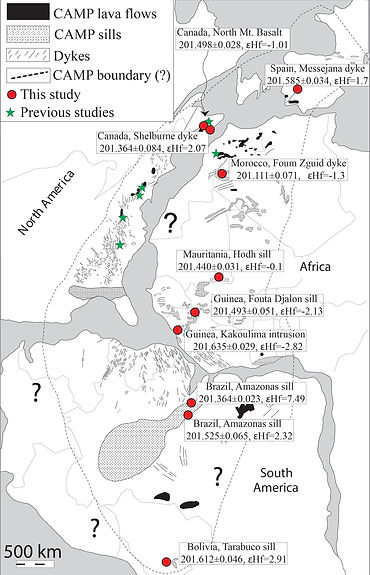Université du Québec à Montréal (UQAM) / Geotop: U-Pb geochronologist
davies.joshua@uqam.ca
Large igneous provinces and mass extinctions
Large igneous provinces (LIPs) are extremely large eruptions of lava which occur over geologically short periods of time. They are often associated with mass extinctions, but not all the time. One of the most important aspects in understanding the link between LIPs and mass extinction is the age of the LIP compared with the age of the mass extinction. In my group we have been working on providing high precision age constraints on different LIPs and determining their relationship with global scale climatic and biotic changes. Below are some examples of our work on LIPs
The Central Atlantic Magmatic Province (CAMP)
We have worked a lot on the Central Atlantic Magmatic Province (CAMP) which erupted at ~201 Ma in areas around the modern northern Atlantic ocean, just before its opening. Our work has shown that the emplacement of the CAMP was co-incident with the End Triassic mass extinction.
We have dated sills from the Amazon sedimentary basin which were emplaced exactly at the onset of the mass extinction. We suggest that the intrusion of the sills into this basin caused thermogenic volatiles to be released from the volatile rich sediments in the basin, as well as magmatic volatiles associated with the large igneous province all of which caused a dramatic change in the climate, resulting in a mass extinction.

Click on picture for paper
More Central Atlantic Magmatic Province (CAMP)
Our work has suggested that the presence of zircon in some of the CAMP samples may be due to the assimilation of sediments like shale.
Assimilation of sediments changes the composition of the magma and also increases volatile concentrations which delays silicate saturation, all of which can promote zircon crystallisation. We suggest that the interaction between the CAMP magmas and the sediments in the Amazon basin may have ultimately been responsible for the mass extinction at the End Triassic, due to thermogenic gas release from the sediments. This interaction may also have created the conditions for us to be able to date the magmas at high precision using the U-Pb technique as well.
The Paraná
We have worked on high precision U-Pb dating of zircon from the felsic irruptive units in the Paraná LIP. Our new ages show that the eruption of the felsic portion of the LIP postdates by ~0.5 Ma, the Valanginian anoxic event in the oceans. This suggests that at least the felsic portion of this LIP was not the cause of the anoxic event. We speculate that because the LIP erupted into and onto quartz arranite sandstones there was very little thermogenic volatiles released from the sediments, which meant the climatic impact of the LIP was very small. Still the question regarding the cause of the Valanginian event remains however.
Click on picture for link to the paper
The Karoo
The Karoo LIP was emplaced in Southern Africa around 183 Ma. Our new high precision U-Pb ages and Hf isotope data from zircon found in different Karoo samples confirm that that Karoo province is temporally correlated to a major global carbon and oxygen isotope excursion, and also the Toarcian oceanic anoxic event. The Karoo LIP intrudes a major sedimentary basin in Southern Africa. This basin contains voluminous shales and evaporite deposits which were likely heated up and metamorphosed during the emplacement of the Karoo LIP, resulting in massive outgassing. We hypothesise that this combined with magmatic outgassing caused the climatic change necessary to form the Toarcian oceanic anoxic event.


